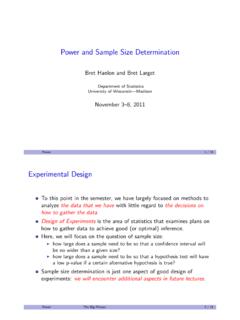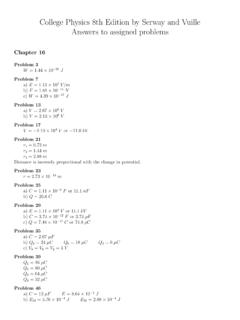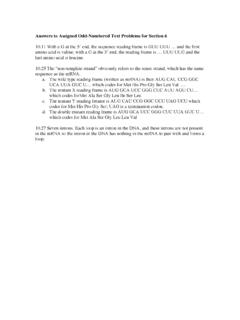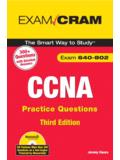Transcription of Stat 371, Cecile Ane Practice problems Midterm #2, Spring 2012
1 Stat 371, Cecile AnePractice problemsMidterm #2, Spring 2012 The first 3 problems are taken from previous semesters exams, with solutions at the end of thisdocument. The other problems are suggested Practice problems from the textbook, with solutionkeys at the end of the The following experiment was run to determine whether or not different flavors of ice creammelt at different speeds. Two flavors (A and B) of ice cream were stored in the same freezerin similar-sized containers. For each observation, one teaspoonful of ice cream was taken fromthe freezer, transferred to a plate, and the melting time at room temperature was observedto the nearest second. Nine observations were taken on each flavor. These are shown in thefollowing table, and the normal probability plots of these data are shown in secondsMeanSDA1009 987 955 1074 994 1040 1037 999 970 980 872 975 1061 963 857 Q Q PlotTheoretical Quantilesflavor Alllllllll Q Q PlotTheoretical Quantilesflavor B(a) Give a 95% confidence interval for the mean melting time of the flavor A ice cream inthe conditions of the experiment.
2 Interpret your confidence interval.(b) Are 95% of the flavor A observations in this confidence interval?(c) Is the method applied in (1a) on the flavor A data set valid for this data set? Give abrief justification.(d) To determine whether flavors A and B have different melting times, three different testswere done with R. Below are the three R outputs. Give the name of each test and thep-value returned by each Welch Two Sample t-testdata: flavorA and flavorBt = , df = , p-value = hypothesis: true difference in means is not equal to 095 percent confidence estimates:mean of x mean of Paired t-testdata: flavorA and flavorBt = , df = 8, p-value = hypothesis: true difference in means is not equal to 095 percent confidence estimates:mean of the Wilcoxon rank sum testdata: flavorA and flavorBW = 65, p-value = hypothesis: true mu is not equal to 0(e) Which test is the most appropriate here and why?
3 Give the conclusion of this test atthe significance level = An experiment was set up to study two drugs, Lipanthyl and Befizal, based on their effecton cholesterol level in blood. A group of 25 men with high cholesterol level were randomlyassigned one of the two drugs. The level of LDL (low density lipoprotein, which is sometimescalled bad cholestrerol) was measured right before the treatment and again after the 3-month treatment.(a) The following table reports the data (in g/l) regarding the 12 men who received in LDL blood level is the after level subtracted from the before level, sothat a negative value actually means an increase in LDL blood the appropriate t-test to test the null hypothesis that the 3-month Lipanthyltreatment does not affect the LDL blood level.
4 Use the significance level = Statethe alternative hypothesis as well as which test you are doing.(b) The following table reports the data (in g/l) regarding the 13 subjects who a sign test to test the null hypothesis that the 3-month Befizal treatment doesnot affect the LDL blood level. Use the significance level = (c) You want to compare the two drugs using a t-test. State the null and the alternative hy-potheses. Perform the appropriate t-test (state which test it is) and state its the significance level = Note: df= (d) Construct a 90% confidence interval for the mean decrease in LDL level after the 3-month Befizal treatment subtracted from the mean decrease after the 3-month Lipanthyltreatment.
5 Interpret your interval. Note: we still have df= (e) An experiment is being planned to study the effect of Lipanthyl on women. In orderto have enough precision to compare it to other drugs on women, it is desired that thestandard error of the mean decrease in LDL level in blood should not exceed that the effect of Lipanthyl has similar standard deviation on men and onwomen, and using data shown above on men, determine how many women should be inthe sample in order to achieve the desired Chronic wasting disease (CWD) is a brain disease of deer and elk, and it is one of a group ofdiseases called transmissible spongiform encephalopathies (TSEs) associated with the presenceof prions. Characterized by long incubation periods, CWD takes years to develop. A studywas conducted over a 3-year period. Deer were caught in the wild and tested for age and sex was recorded, along with the region (core area or marginal area) wherethey were caught.
6 (a) The following table summarizes the data from deer caught in the core area, of age 2 yoor more. Test the null hypothesis that the proportion of infected animals is the sameamong females and among males. Use = not infectedfemales31182males33138(b) Determine whether the method used in (3a) is valid for the data at hand.(c) Determine, in the sample, how many animals caught in the core area of age 2 yo or morewere males, and how many were females. Test the null hypothesis that, when catchinga deer in the core area, there is a 50% chance that this animal is a male (or a female).Use the significance level = (d) The following table gives the number of infected and not infected animals according tothe region. Test the null hypothesis that the proportion of infected animals is the samein the core area and in the marginal area ( = ).
7 State the conclusion of the : calculations yieldX2= not infectedcore area86944marginal area903142(e) The following table gives the repartition of deer by age and region. Test the null hypoth-esis that the repartition by age is the same in the core area and in the marginal area( = ). State the conclusion of the test and determine whether the method you areusing is valid for the data at (in years)012 3core area360 286 230 154marginal area956 911 841 524(f) Are these data observational or experimental?(g) Do you have any concern about the sample being representative of the deer population?(h) Comment briefly on the results of questions (3d) and (3e).3In the following problems , keep asking yourself what the best method of analysis is. Whyindependent or why paired t-test? Why non-directional (two-sided), or why directional (one-sided)test?
8 Why or why not sign test? Why or why not Wilcoxon-Mann-Whitney test? Why or why not 2test? I encourage you to ask yourself those questions even though problems from chapter 8 or 9are for categorical data (binomial test, z-test or 2test) and problems from chapter 12 or 13 are fornumerical data (various t-tests, sign test or Mann-Whitney test). On the exam, you will not knowwhich chapter the problem is attached to. answers to Practice problems start on page 613 of , & up: Practice problems 2, 8, , & up: Practice problems 1 (replace odds of capture by probability of capture for b),2, 4, 5, 6, 7, 10 (but replace odds ratio by difference in probability of digital birth defect). , & up: Practice problems 1, 3, 4 (answer a using b), 6, 8, 10 (answer a using b). , & up: Practice problems 1, 2, 3, 4, 7, 8, 11, 12, , & up: Practice problems 1, 2(a), 3, 5 (but tricky), 6, 7, 8, 10, 11, 12, 13, 14, , & up: Practice problems 1, 2, 3, 5, 6, 7, 8, 9, to problems 1-3:1.
9 (a) SE= 9 = seconds, df=9-1=8 so that the multiplier ist= and theinterval is 1012 , (985,1038). We are 95% confident that the averagemelting time of a flavor A teaspoonful of ice-cream in the conditions of the experiment(room temperature, container and freezer) lies between 985 and 1038 seconds.(b) No, they need not be. Only 6 observations out of 9 are in the interval actually.(c) Yes: the distribution of the observations seems fairly normal from the normal proba-bility plot (left plot). Observations can be considered as independent (if the freezer stemperature is considered as constant, even though the freezer is opened before eachobservation).(d) obvious. Circling the names and the p-values was fine.(e) #1: independent sample t-test, because samples A and B are independent, and normalprobability plots are straight enough.
10 (there might be a problem in flavor B, but nota skewness problem . It looks more like a symmetry problem , which is less important).The Wilcoxon-Mann-Whitney test #3 is also appropriate. Both tests #1 and #3 agreethatH0should be rejected at the significance level We conclude that the 2 flavorshave different average melting times, flavor B having the lowest. (So here the Wilcoxon-Mann-Whitney test has enough power to detect the difference between the two flavors).2. (a) We do a paired sample t-test, because measurements before and after are made onthe same individuals. Non-directional test, because there is no prior idea : decrease6= 0 . The mean decrease is .356, its SE=.128/ 12 =.037 andts= = We use a t-distribution with df=12-1=11 and get a p-value<. rejectH0: There is strong evidence that the LDL blood level decreases on averageafter the 3 month Lipanthyl treatment.















